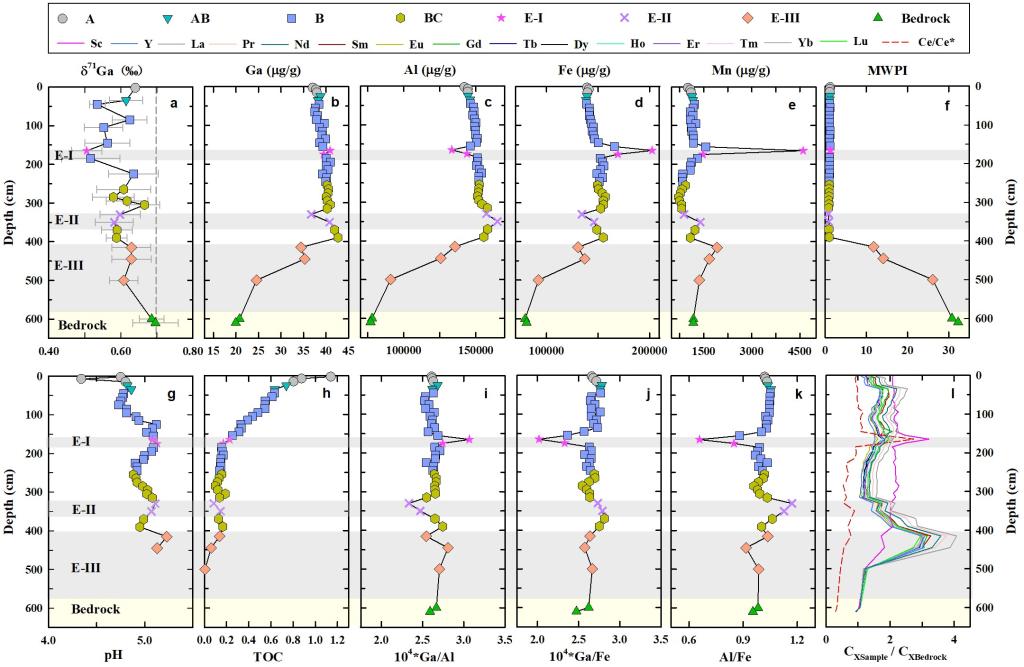The chemical weathering of silicate rocks plays an important role in the biogeochemical cycle of elements and soil formation. It may control the transport of metal ions (e.g., Ca2+, Mg2+) from continental rocks through rivers to oceans, atmospheric CO2 concentration, and climate change. The recently-developed gallium (Ga) isotope systematics could potentially be used to provide important constraints on the silicate weathering process. Ga is a metallic element close to non-metals in column IIIA of the periodic table. It exists only in the trivalent state (Ga3+) in nature, thus is rarely influenced by redox process. Ga is not a biologically essential element for most organisms, so geological samples usually contain negligible Ga contributions from biological materials compared with many life-essential metal elements such as Zn, Cu, and Fe. More importantly, Ga has been considered as a potential analog of Al in geochemical studies, as both elements from the same group in the periodic table have similar chemical properties.
Aluminum (Al) is a major constituent of rock-forming minerals (e.g., feldspars, micas, and clay minerals). During chemical weathering, it is often involved in the formation of secondary minerals that are keys to the fixation of other metal elements through adsorption/desorption or dissolution/coprecipitation. However, because Al has only one stable isotope (27Al), the isotopic approach is not applicable to quantify Al behavior during chemical weathering. Although previous studies have shown that isotopes of elements such as Mg, Ca, Ba, K, and Li are powerful tools in investigating chemical weathering and the relative climatic and environmental effects, none of them acts as a reliable proxy for trivalent Al due to their remarkably different physicochemical properties (e.g., valence and ionic radius). Ga has two stable isotopes, 69Ga and 71Ga, with natural abundances of ~60.1% and ~39.9%, respectively. As such, Ga and its isotope composition could be effectively used for tracking weathering processes. However, the application of Ga isotopes as a potential proxy for silicate weathering has yet to be systematically investigated.
Therefore, we determine Ga isotopic composition of a typical latosol profile developed on late Cenozoic basaltic bedrock from the Leizhou Peninsula, Zhanjiang, Guangdong Province, South China. We characterize Ga isotope behavior during the extreme alteration of basalt, discuss factors that control Ga isotope fractionation at Earth’s surface conditions, and test the effectiveness of Ga isotopes as a proxy for chemical weathering.
Most Ga in the weathering profile is present in residual Al-rich and/or Fe-rich minerals. The δ71Ga values in the profile vary from 0.69 ± 0.05‰ in the fresh parent basalt to 0.51 ± 0.04‰ in the strongly-weathered samples, indicating 71Ga preferentially enters the hydrosphere and the 69Ga is more likely to remain in soils during basalt weathering. Similarly, δ71Ga values are also controlled by residual minerals including Al-bearing (e.g., clay minerals) and Fe-bearing (eg., Fe oxides) minerals. Interestingly, our results show δ71Ga values of latosols display a bigger variation (about 3-4 times of its analytical uncertainty) than their Ga/Al ratios (about 1.5 times of its analytical uncertainty) throughout the profile, indicating δ71Ga values may be a more sensitive proxy to track the loss of Al3+ and involvement of Fe3+ during weathering process. Based on τNb,metal values present in this profile, the mobility sequence of these elements can be determined to be in the order of Ba > Si > Mn > Fe > Ga > Al > Ti during basalt weathering, indicating the mobility of Ga might provide important reference value for other immobile elements. The Ga isotope fractionation factor (α) calculated based on tNb,Ga provides a high limit of 1.50‰ (Δ71Gasolution-weathered rocks). Furthermore, our results indicate redox condition and water supply may have some impacts on the Ga isotope fractionation, as shown in the Fe/Mn-rich horizons (E-I layer) and Al-minerals horizons (E-II layer), Ga isotopes may thus be a useful tracer for paleoenvironment.

Figure 1. Variations of the important parameters with depth.
These findings were published in journal of Geochimica et Cosmochimica Acta. The first author and corresponding author is Wei Yuan and Prof. Jiubin Chen from Tianjin University, respectively. This study was financially supported by the Ministry of Science and Technology of the People’s Republic of China (2019YFC1804400), and the National Natural Science Foundation of China (41973007, 41625012, 41961144028, 41830647).
Full article:
Yuan, W., Gong, Y., Chen, J.*, Wang, Z., Huang, F., Yang, X., Bouchez, J., Teng, H. and Schott, J., 2022. Gallium isotope constraints on the intense weathering of basalt. Geochimica et Cosmochimica Acta 333: 22–38. https://doi.org/10.1016/j.gca.2022.06.042
Yuan, W., Chen, J.*, Teng, H., Chetelat, B., Cai, H., Liu, J., Wang, Z., Bouchez, J., Moynier, F., Gaillardet, J., Schott, J. and Liu, C., 2021. A Review on the Elemental and Isotopic Geochemistry of Gallium. Global Biogeochemical Cycles 35: e2021GB007033. https://doi.org/10.1029/2021GB007033